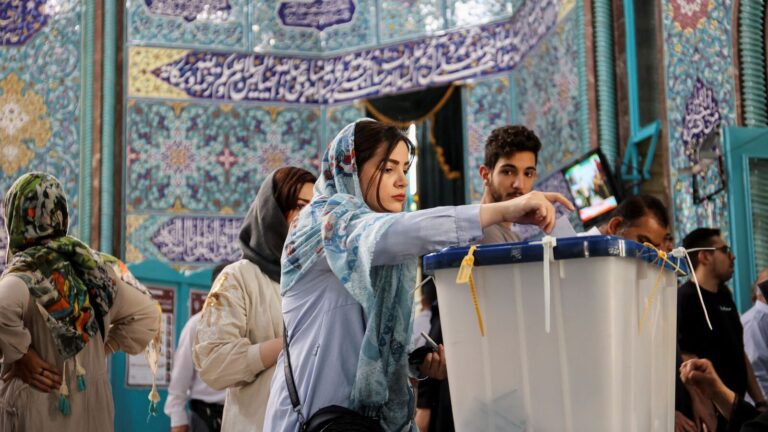Iran’s presidential election on Friday will not only determine who will lead a country increasingly hostile to the West, but will also help shape succession plans for the next supreme leader and signal whether Iranians are ready to abandon their Islamic system of governance.
The election pits the leading reform candidate in the polls, Massoud Pezeshkian, who supports renegotiating with the West, against several hardliners who want to deepen ties with Russia and China, strengthen the alliance of anti-Israel militias, and advance the country’s nuclear program. There is no clear favorite, and if no candidate receives a majority, a runoff election will be held between the top two vote-getters.
The election was triggered by the death last month in a helicopter crash of President Ebrahim Raisi, a one-term hardline cleric who was seen as a possible successor to Supreme Leader Ayatollah Ali Khamenei, who is 85 and in poor health. No one outside Iran has access to the details of the succession talks, but Iran experts say Raisi’s death has eliminated any safe option.
The vote will be an informal referendum on the Iranian regime, two years after protests calling for its overthrow rocked the streets and were violently suppressed. Raisi was elected in 2021 in Iran’s first presidential election in which less than 50% of voters took part, but opinion polls suggest turnout this time could be even lower.
Still, many Iranians don’t see the value in voting for the narrow list of candidates approved by Khamenei. Andia, a 37-year-old Tehran resident who took part in the 2022 protests, said she won’t vote because popular moderate Ali Larijani has been barred from taking part.
“This election doesn’t change anything for me,” she said.
Most opinion polls suggest the race is dominated by three candidates: Pezeshkian, who supports reopening nuclear negotiations with Washington and other powers and calls for curbs on Iran’s nuclear program in exchange for lifting international sanctions; Saeed Jalili, an adviser to Khamenei, a hardliner who opposes any compromise on Iran’s nuclear program or any relaxation of the regime’s requirement to wear the veil for women; and Mohammed Bagher Ghalibaf, speaker of Iran’s parliament, known as a pragmatic conservative who calls for limited renegotiations with the West.
According to a poll published by the Iranian Students’ Public Opinion Research Organization, which is affiliated with a research center close to the government, Pezeshkian was leading with 33.1 percent of the vote as of Wednesday, followed by Jalili with 28.8 percent and Ghalibaf with 19.1 percent.
The election comes at a critical time for Iran, which is under intense international scrutiny over its nuclear program, which it claims is peaceful, and its military support for Russia in its war against Ukraine. Iran came close to war with Israel in April after the two countries attacked each other on Iranian soil for the first time.
The government is also addressing deep-rooted young people’s discontent with a dysfunctional economy and restrictions on freedoms that surfaced in 2022 with mass protests over a woman who was arrested for not wearing a proper headscarf and died in police custody.
Polls close on Friday, but final results may not be announced until Sunday. If no candidate receives more than 50% of the vote, the two leading candidates will compete in a second round on July 5.
Under the theocratic system established by founding father Ayatollah Ruhollah Khomeini after the 1979 revolution, the president has much less power than the de facto head of state, the supreme leader, who must be a senior cleric, who has the final say on the country’s most important issues, from political and social change to the nuclear program.
But a president can steer the country in a more hardline or softer direction, and the presidency is seen as a stepping stone to becoming supreme leader. Khamenei was Iran’s president in the 1980s.
Analysts see Ghalibaf as a favoured choice of the Islamic Revolutionary Guard Corps, the powerful paramilitary organisation that defends the country against any threat to its governing system.
Ghalibaf is a former IRGC commander who was involved in the violent crackdown on Iranian university students in 1999 and 2003. He has since moderated his stance, calling for limited reforms and opposing excessive repression during the 2022 protests. In foreign policy, he supported the 2015 nuclear deal but rejected it because it did not improve Iran’s economy.
By contrast, Mr. Jalili represents a faction known as the “Ultra-revolutionaries,” a group that seeks a return to the fervent spirit of the regime’s early years. Mr. Jalili has railed against the 2015 nuclear deal, saying it favored countries “that are most hostile to the Iranian people.”
Mostafa Pakzad, an independent Iranian geopolitical analyst, said Ghalibaf was “totally committed to the Islamic system, but it is guided in a pragmatic way.”
Pezeshkian, the only reformer among the five officially recognized conservative lawmakers, suggested Iran was to blame for the economic crisis, later pointing to mismanagement linked to Iran’s nuclear program and international sanctions. “The responsibility is on us,” he said on state television on Monday.
Iranian analysts say Pezeshkian was allowed to run to ensure disaffected Iranians turned out to the polls, as Khamenei fears most Iranians will stop voting for their own list of candidates, resulting in a loss of legitimacy.
“Khamenei and the core faction recognize the need for more competitive elections,” said Sina Toussi, an Iran expert at the Center for International Policy, a Washington think tank.
At town hall meetings with the reformist Pezeshkian, young Iranians said they had little hope for change.
“Your generation came to the conclusion that they had no common language with the government, so they started a revolution,” one woman said in an exchange broadcast on state television. “Our generation has reached this level.”
Write to Benoit Faucon at benoit.faucon@wsj.com.

